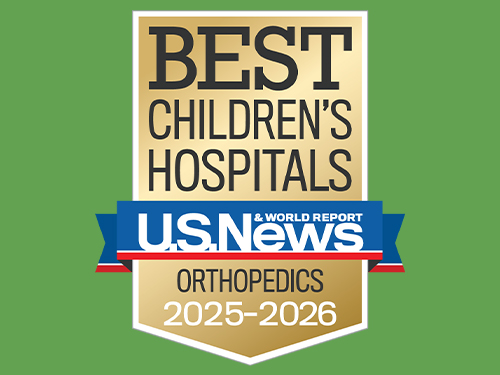Legg-Calve-Perthes disease is a childhood disease that occurs when not enough blood is supplied to the ball portion of the hip joint. Insufficient blood flow causes the joint to become unstable and the bone to easily break.
Causes of Legg-Calve-Perthes
The cause of insufficient blood flow to the hip joint is unknown.
Symptoms of Legg-Calve-Perthes
The most common symptoms of Legg-Calve-Perthes disease are:
- Limping
- Pain or stiffness in the hip, groin, thigh or knee
- Limited range of motion within the hip joint
Male children between the ages of 4 through 8 appear to be at higher risk for developing this condition. It is also more common in children of European, Asian and Eskimo ancestry. Additional risk factors include:
- Smaller size for chronological age
- Delayed maturity
- Exposure to secondhand smoke
- Blood clotting abnormalities
Legg-Calve-Perthes disease usually involves one hip; however, both hips are affected in some children, usually at different times. If your child begins limping or complains of hip, groin or knee pain, schedule an appointment with your doctor for a full examination.
Diagnosis of Legg-Calve-Perthes
A physical exam, which may include a check of the child’s range of motion, will be required in order to diagnose Legg-Calve-Perthes. Additionally, imaging tests will be utilized to confirm the results of the physical exam and may include X-rays, MRIs and bone scans.
Legg-Calve-Perthes Treatment
Therapeutic Treatment Options
The goal of treatment for Legg-Calve-Perthes is to keep the ball of the hip joint round so that it fits securely into the socket. A few common, nonsurgical treatment options include:
- Physical therapy: With physical therapy, the goal is to maintain flexibility within the hip and joint with consistent stretching of the hip muscles and ligaments.
- Crutches: Physicians may also recommend crutches to avoid putting any weight on the affected hip.
- Traction: Traction (a steady and gentle pulling on the leg) is used to treat severe pain and will most likely include bed rest.
- Casts: A leg cast may be used to position both legs wide apart for four to six weeks. Once the cast is removed, a brace may be utilized to maintain optimal hip flexibility.
Surgical Treatment Options
In addition to therapeutic treatment, surgery is another option to consider. There are several approaches to surgery, which include:
- Contracture release: With contracture release, surgery is used to lengthen the hip muscles and tendons that have shortened and caused the hip to pull inward.
- Joint realignment: Surgery for joint realignment focuses on restoring the normal shape of the hip joint, using small cuts in the femur bone or pelvis to realign the joints.
- Removal of excess bone or torn cartilage: For patients with restricted movement, it may be helpful to remove any extra bone or damaged cartilage from the joint using realignment surgery to alleviate pain and to regain additional joint movement.
- Joint replacement: Joint replacement surgery may be required at some point due to the degenerative effects of the disease on the hip joints.
Contact Us
If you have any questions, use the online tool below to help us connect with you. To schedule an appointment, please contact our clinic using the information below.
Children's Memorial Hermann Hospital
6411 Fannin
Houston, TX 77030
Phone: (713) 486-4880
To contact Children's Memorial Hermann Hospital, please fill out the form below.
If you are experiencing a medical emergency, call 911 or go to the nearest emergency room.
If you or someone you know needs support from the Suicide and Crisis Lifeline, call or text 988.
